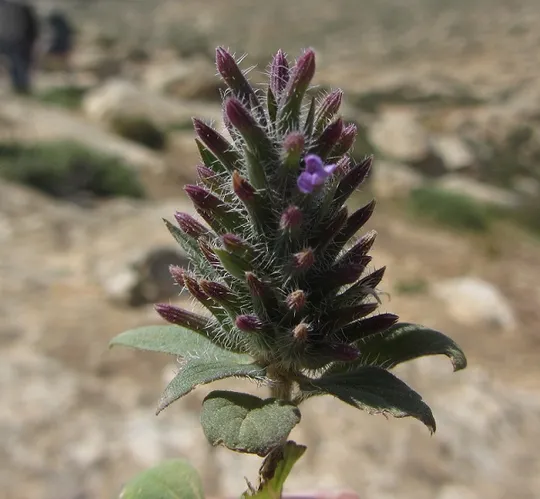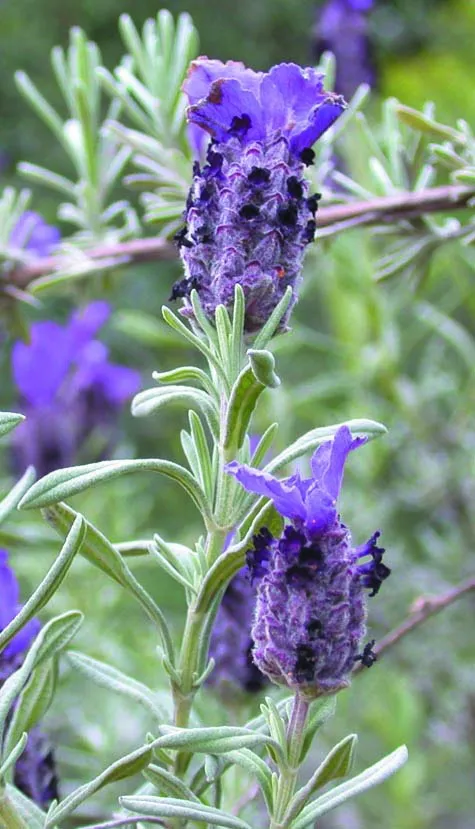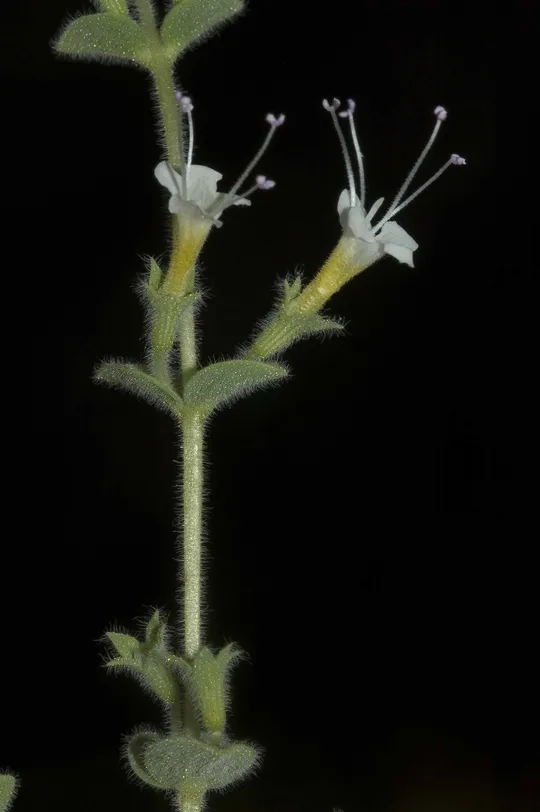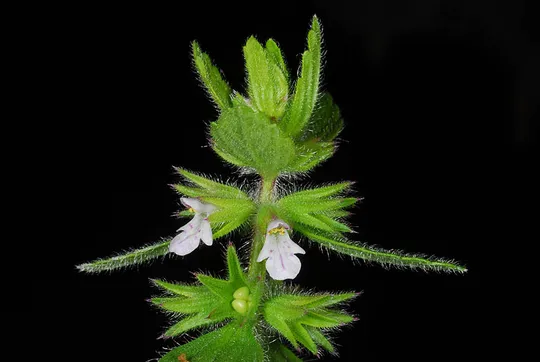Fragrant Acinos
Clinopodium graveolens

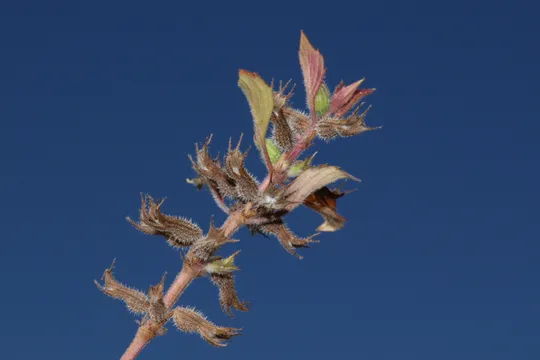
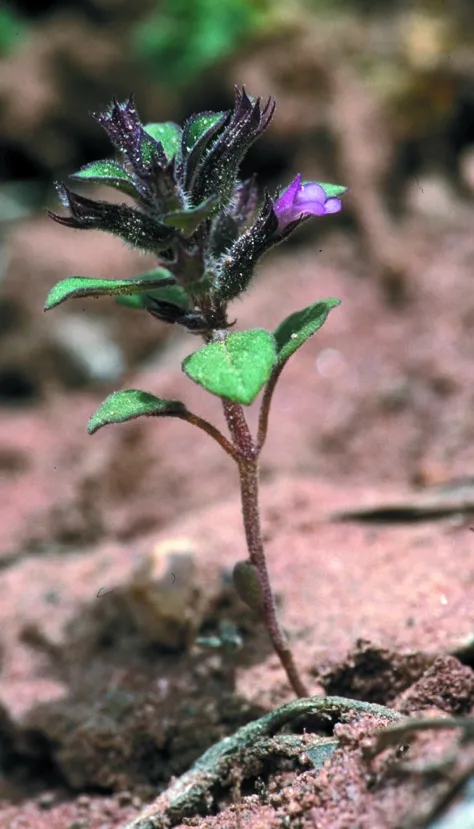
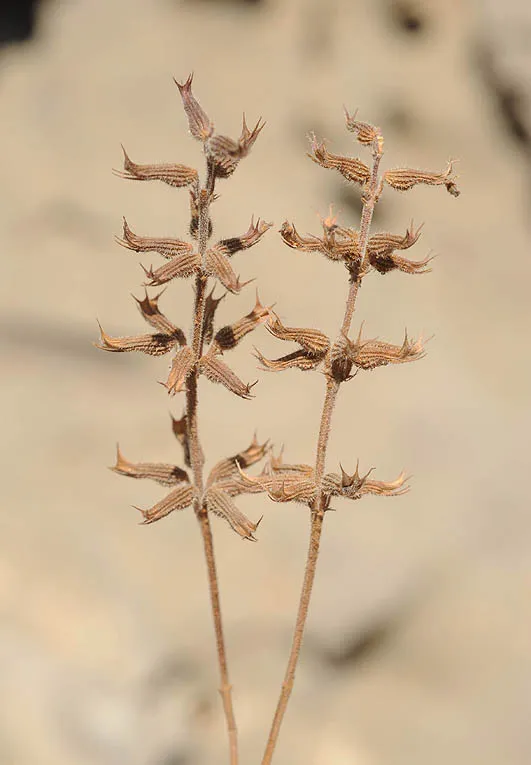
Acinos rotundifolius is a tiny annual plant, 5-9 cm tall. The leaves are arranged in opposite pairs along the stem, borne on the clear pedicel that abruptly expands into a broad round or oval blade. The leaf is 10-28 mm long and 5-8 mm wide. The inflorescence has few flowers, arranged in pairs in leaf axils, scattered along the stem (there is no separation between the stem leaves and the inflorescence leaves). The pedicel is slender and shorter than the calyx. The calyx is slender, tubular, 6-8 mm long, arched at its center with a hairy throat and ends in a 5-toothed limb that is a continuation of the calyx, creating a two-lipped structure, with two teeth on the upper lip and three on the lower one. The teeth on the upper lip are lanced and the ones on the lower lip are awl-shaped. The pink corolla is two-lipped and its slender tube is concealed within the calyx. The fruit contains four smooth mericarps and remains inside the calyx when ripe. The leaves have a spicy aroma. A. rotundifolius blooms in early April in the Judean Mountains and in mid-May on Mount Hermon.
Acinos rotundifolius is fairly common in the mountainous zone of the Hermon at an altitude of 1450-2100 m. West of the Jordan River it grows only in the Judean mountains, where it has been found only three times in the 1940s – twice in Jerusalem and once in Gush Etzion. Since then no plants were collected from either Jerusalem or Gush Etzion, despite all efforts made. In 2002, a large population was discovered on the Ma’on Ridge in the southern Judean Mountains. The species is relatively common in the area of Mitspe Ya'ir-Havat Ma'on, and it is gradually spreading north to Bet Hagay and to the Giv’at HaHarsina woodland in Hebron.
Rocky slopes on limestone substrate; is also found on the edges of alluvial land in the area of the central mountain range and watershed in Judea and Hebron.
The genus Acinos includes only 2-3 species that are common in the in the Middle East and in southern Europe. Systematically the genus Acinos is very close to the genera Calamintha and Clinopodium, and some unite the three genera under the previous name of the genus – Clinopodium. Acinos rotundifolius is a northern genus, which includes 20 species that grow in the temperate and Mediterranean regions of the Old World and some of them are known as excellent herbs.
In our region, three different genera of the Lamiaceae family grow, dwarf annual species, upright and 4-7 cm in size: Ziziphora capita (and Z. tenuior), Sideritis curvidens and Acinos rotundifolius. All have similar pink flowers and leaves longer than the flowers. They differ in the shape of the calyx: in the genus Ziziphora the calyx tube is very narrow and not noticeably bilabiate; In Acinos and Sideritis, onthe other hand, the calyx teeth are long and clearly bilabiate. In Acinos the upper lip of the calyx has two teeth, whereas Sideritis has only one tooth, broad and upright. All these species belong to the highland ecotone, i.e. they grow in the mountains in a steppe climate with a partially snowy winter and a very dry summer. They use the period following the spring thaw for rapid growth, and succeed, because of their small size, to produce seeds and complete their growth cycle before the ground dries (their roots reach a depth of 10 cm). Additional species belonging to this biogeographic group of miniscule annual plants that grow in the steppe highlands of the Middle East are Viola modesta, Arabidopsis pumila, Scandix stellata, Malcolmia crenulata and Arabis auriculata. These are probably last remnants of populations from an ancient colder climatic period.
• Acinos rotundifolius populations found in the Ma’on ridge are all concentrated around the settlement of Mitspe Ya'ir, and endangered because of development plans.
• There is considerable fragmentation between the populations on Mount Hermon and those on the Ma’on ridge
• The species is common on Mount Hermon, in the Mediterranean countries and in the Irano-Turanian region. It is not in globally endangered.
• A. rotundifolius is not protected in a nature reserve (except for Mount Hermon).
At least one area in the Ma’on ridge area should be allocated and declared a traditional agriculture reserve. In the reserve, traditional cultivation methods should be preserved and deep plowing, pesticide spraying and mechanical injury should be proscribed. The site should be monitored.
The plant is common in the west of the Irano-Turanian and Mediterranean regions: from Spain through Greece, Crete and Turkey east to Iran and Central Asia. In the southern Mediterranean: Morocco, Algeria and Tunisia. Penetrates the Black Sea region. Relatively common in Jordan in the Moab, Edom and Ammon highlands.
Acinos rotundifolius is a miniscule annual plant common on Mt. Hermon and in Jordan, but very rare in western Israel, where it grows only in a single fragmented site on the Ma’on ridge, at the southern edge of its range. It is important to preserve it, although it is not endemic, nor attractive enough to be damaged or picked, because of the biogeographic uniqueness of its distribution and its connection with a traditional agriculture habitat that is rapidly vanishing.
Current Occupancy Map
| 1000 squre meter pixel | 5000 squre meter pixel | 10000 squre meter pixel | |
|---|---|---|---|
| number of observations | 0 | 0 | 0 |
| in total pixels | 0 | 0 | 0 |
| Family | Lamiaceae |
| Classification | On the endangered species list |
| Ecosystem | High Semi-Steppe |
| Chorotype | Irano – Turanian (Mediterranean) |
| Conservation Site | Mitspe Ya'ir fields, in Ma’on ridge |
| Rarity |
1
6
6
|
|---|---|
| Vulnerability |
0
1
4
|
| Attractiveness |
0
0
4
|
| Endemism |
0
0
4
|
| Red number |
1
4.2
10
|
| Peripherality | N |
| IUCN category | DD EW EX LC CR EN VU NT |
| Threat Definition according to the red book | Endangered |
 Based on:
Based on:
